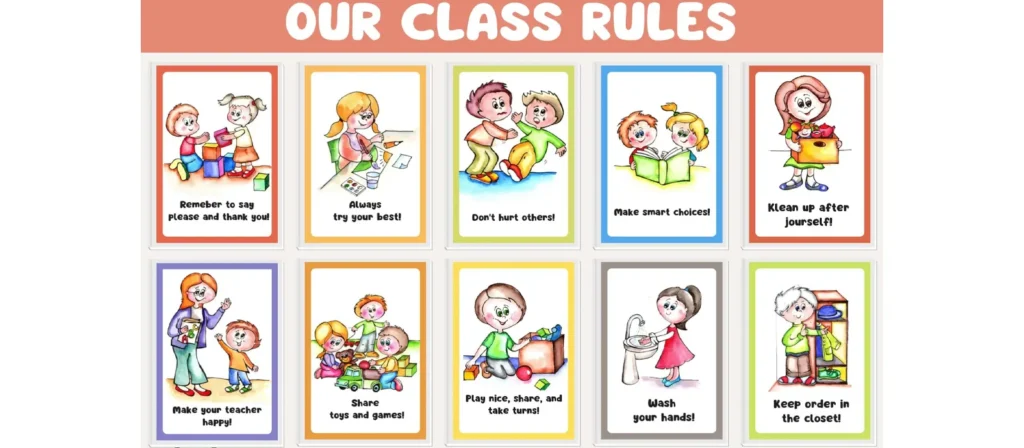幼稚園で、体系的で落ち着いた、生産性の高い学習環境の構築に苦労していませんか?小さな学習者たちは、教室で期待されたことをすぐに忘れてしまうようですか?良い行動を促すルールを作るための実践的なヒントをお探しですか?
幼稚園の教室ルールを作ることは、子どもたちが安心し、尊重され、学ぶ意欲を持てる環境を作る上で非常に重要です。シンプルで明確、そして前向きなルールは、秩序を維持し、社会性と情緒の発達を促します。子どもたちが理解できるガイドラインを設定することで、協力的で魅力的な教室の雰囲気を育むことができます。
しかし、幼い子どもたちの心に響くようなルールをどう作ればよいのでしょうか?どんな幼稚園の環境でも通用する教室ルールを作るためのプロセス、メリット、そしてベストプラクティスを探ってみましょう。
幼稚園の教室のルールとは何ですか?
幼稚園の教室ルールは、教育者が整然とした、安全で、敬意のある学習環境を促進するために定めたガイドラインです。これらのルールは、子どもたちが理解するのに役立ちます。 許容できる行動責任感を育み、社会性、情緒、そして教育的ニーズを満たすことを目指します。就学前教育においては、これらのルールはシンプルで覚えやすく、視覚教材、歌、インタラクティブなアクティビティを通して伝え、理解を深めることが重要です。
幼稚園の教室で明確に定められたルールがあれば、教師は秩序と集中力を維持しながら、子どもたちに安心感と予測可能性を与えることができます。ルールは肯定的なもので、子どもたちが望ましい行動をとれるように構成されるべきです。例えば、「意地悪をしてはいけない」と言うのではなく、「優しい言葉を使いなさい」と言うように。効果的なルールは、子どもたちに明確な期待を与え、ひいては学習体験を向上させます。
幼稚園の教室ルールを設定することの利点
幼稚園の教室ルールを作るのは、小さな作業のように思えるかもしれませんが、そのメリットは計り知れません。幼稚園の教室ルールは、整然とした環境を整えるだけでなく、子どもたちの発達と成長の基盤を築くことにもなります。

- 尊敬と共感を促進する: ルールを定めることで、子どもたちは自分自身、仲間、そして周囲の環境を尊重することを学びます。これらのルールは、子どもたちが他の人の話に耳を傾けたり、自分の順番を待ったりする際に、共感力を養うために作られています。
- 混乱を軽減: ルールがないと、教室は混乱してしまいます。明確な境界線があれば、子どもたちが騒がしい行動をとる可能性が低くなり、より集中力と生産性のある学習環境につながります。
- 責任感を育む: 教室における幼児向けのルールは、子どもたちに自分の行動には結果が伴うことを教えます。ルールを守れば、誰もが調和のとれた安全な空間を創り出すことができます。この責任感は、幼児教育の重要な要素です。
- 安全な環境を促進します: 「走らないで」「手を離さないで」「優しい言葉をかけなさい」といった幼稚園の教室のルールは、怪我を防ぎ、心の安定感を育むのに役立ちます。幼稚園児は境界線を知ることで安心感を覚え、学習や遊びに集中できるようになります。
- 社会的なスキルを促進: 「友達とシェアする」や「順番を守る」など、幼稚園の教室でルールを設定すると、未就学児が他の人と積極的に関わるようになり、それが幼い頃から社会性を身につける鍵となります。
ルール作成前の準備
効果的な幼稚園の教室ルールを確立する前に、観察、考察、そして協力に時間をかけることが不可欠です。いきなりルール設定に飛びつくのではなく、綿密な準備を通して、作成されたルールが教室の基本的なダイナミクスに根ざしたものになるようにします。その土台を築く方法をご紹介します。
自然な行動とグループのダイナミクスを観察する
子どもたちが一日を通してどのように行動しているかを、数日間観察してみましょう。移動時間、遊びの時間、食事の時間、グループ活動など、様々な場面で観察してみてください。整列中に押し合ったり、読み聞かせの時間に大声を出したりといった問題が繰り返し発生していませんか?これらの観察を通して、どの部分に指導が必要か、そしてどのルールがクラスにとって意味があり、適切であるかを特定することができます。
教室環境を評価する
教室の物理的な配置は、想像以上に子どもたちの行動に影響を与えます。教材は簡単に利用できますか?過度の刺激を防ぐのに十分な居心地の良い空間はありますか?特定の行動が環境的な要因によるものかどうかを検討しましょう。教室のレイアウト、流れ、視覚的なヒントを調整することで、過度に制限的なルールの必要性を軽減できるかもしれません。
副担任やサポートスタッフとのコミュニケーション
ルールは、教室にいるすべての大人が同じ基準を遵守しているときに最も効果的に機能します。時間をかけて、教員チームと連携を取りましょう。過去の成功例や課題について話し合い、一貫した言葉遣いと期待される内容について合意しましょう。教員間の一貫性は、後々のルール遵守の強固な基盤となります。
プログラムまたは学校全体の行動方針を確認する
一部の学校では、教室での期待を規定する包括的な行動規範(PBISやモンテッソーリ原則など)を設けています。これらのガイドラインを理解することで、ルールが効果的であり、より広範な組織の価値観と整合していることを確認できます。
幼稚園の教室ルールを作成する際に考慮すべきこと
作成する際にはいくつかの重要な要素を念頭に置いてください 幼稚園の教室 ルールは非常に重要です。ルールは、就学前のお子様の発達段階や理解度に合わせて調整する必要があります。考慮すべき点は以下のとおりです。
- ポジティブな言葉遣い: Use language that tells children what to do rather than what not to do. Instead of saying, “Don’t run,” say, “Walk inside.” Positive phrasing promotes a solution-focused mindset and helps children understand expectations clearly and supportively.
- シンプルで実用的: Rules should be short, specific, and easy to remember. Avoid abstract concepts like “Be responsible.” Instead, use clear actions such as “Put toys away after playing.” Actionable rules give children concrete behavior to follow.
- 数量限定リストは短く、理想的には3~5個の基本ルールに絞りましょう。未就学児は一度にたくさんのルールがあると圧倒されてしまうことがあります。優しさ、安全、聞くことなど、教室のほとんどの場面で当てはまる基本的な行動に焦点を当てましょう。
- ルーチンに沿った: Design rules that directly support classroom activities and transitions. For example, if clean-up time often leads to resistance or confusion, include a rule like “Put toys back where they belong.” Connecting rules to everyday routines helps children see their purpose and apply them naturally throughout the day.
- 発達段階に適した: Match the language and complexity of each rule to your student’s age and understanding. Younger children need very concrete visual cues, while older preschoolers may handle simple reasoning behind rules.
- 視覚的に強化: それぞれのルールを、絵、図表、またはストーリー性のあるビジュアルを使って補足しましょう。未就学児は視覚的に学習するため、分かりやすい画像やアイコンでルールを示すことで学習効果が得られます。これは、非言語学習者や言語習得の初期段階にある子どもにとって特に役立ちます。
- 観察可能かつ測定可能: Make sure each rule describes a behavior that teachers can see and children can practice. Instead of saying, “Be good,” say, “Use kind words,” or “Take turns.” This allows for consistent reinforcement and feedback.
- 包括的かつ敬意を持って文化的背景や異なる行動規範に配慮しましょう。特定の社会的規範を他の規範よりも優遇することなく、共通の価値観を反映したルールを作りましょう。可能な限り、家族や保護者にもルールの理解と支援を促しましょう。
- 一貫して施行ルールが定められたら、教室にいるすべての大人はそれを一貫して適用しなければなりません。予測可能な結果と強化は信頼を築き、子どもたちに安心感を与えます。一方、一貫性がないと、混乱が生じたり、境界線を試したりする可能性があります。
- 子ども向け情報できる限り、子どもたちにルールの言い回しやイラストの作成を手伝ってもらいましょう。「みんなが安心できる理由は何ですか?」と尋ね、子どもたちの言葉や絵を教室のポスターに載せるなど、簡単なことから始められます。子どもたちの参加によって、ルールへの関心と主体性が育まれます。
幼稚園の教室ルールの作り方
Now that we’ve covered the importance and key considerations let’s explore how to create effective preschool classroom rules. This process should be thoughtful and intentional, creating a space where children feel respected and motivated to learn.

ステップ1: ルールをシンプルかつ明確にする
未就学児の集中力は限られており、まだ善悪の基本的な概念を学んでいる段階です。ルールの数は扱いやすい範囲に抑えましょう。理想的には3~5個程度です。ルールは明確に、そして肯定的な言葉で表現しましょう。例えば、
- 「優しい言葉を使いましょう。」
- 「手と足を自分の体から離しておいてください。」
- 「先生の言うことを聞きなさい。」
- 「おもちゃを交代で使いましょう。」
ステップ2:子供たちとルールについて話し合う
幼稚園の教室のルールを子どもたちに理解してもらうために、説明することは不可欠です。簡単な言葉を使い、良い行動と悪い行動の例を挙げましょう。例えば、「優しい言葉を使うってどういうこと?『お願いします』『ありがとう』を言うこと、そして意地悪なことは言わないことだよ」などです。
ステップ3:ビジュアルを使ってルールを強化する
未就学児向けの教室のルールを描いた絵は、子どもたちに期待される行動を思い出させるのに効果的な方法です。ルールについて話し合った後、それぞれのルールを表す絵やイラストを使った視覚的なチャートを作りましょう。例えば、「他の人が話しているときは聞く」というルールを表すには、静かに座っている子どもの絵を使います。このチャートを、子どもたちが毎日見やすい場所に貼っておきましょう。
ステップ4:望ましい行動をモデル化する
子どもは大人の行動を観察して学びます。教師や保護者として、子どもたちに見せたい行動を真似して示しましょう。子どもたちに優しさを求めるなら、子どもたちや他の人との関わりの中で、あなた自身も優しさを示しましょう。
ステップ5:肯定的な行動を強化する
幼稚園のルールを守るよう、褒め言葉やご褒美を使って子どもたちを励ましましょう。子どもがルールを守った時は、「お友達とおもちゃをシェアできてよかったね!」など、具体的に褒めてあげましょう。ポジティブな励ましは、子どもたちが良い行動を誇りに思い、ルールを守る意欲を高めます。
ステップ6:不適切な行動に冷静に対処する
良い行動を促したい気持ちはわかりますが、問題行動は子どもの発達過程における正常な過程です。子どもがルールを破った時は、冷静に対処し、正しい行動へと導いてあげましょう。例えば、「このクラスでは優しい言葉を使うので、今度は優しい言葉で言い直してみましょう」などです。
How to Guide Young Learners to Follow the Rules?
未就学児に教室のルールを守らせるには、忍耐、一貫性、そして創造性が必要です。幼い子どもたちはまだ自己統制と社会的な期待への理解を発達させている段階なので、優しく、繰り返し、そして興味を持ってもらえるような指導が大切です。以下は、子どもたちをサポートするための実践的な戦略です。

- 期待される行動をモデル化する子どもは大人の観察を通して最もよく学びます。「お願いします」「ありがとう」を言う、落ち着いて歩く、他の人と分かち合うなど、見習いたい行動を実際に見せてあげましょう。言葉だけで注意を促すよりも、一貫して模範を示すことで、期待をはるかに効果的に強化できます。
- 視覚的および口頭によるリマインダーを使用する: Repetition is key. Point to the classroom rule chart, use hand gestures or say the rule aloud when relevant. For example, before circle time, gently remind: “Let’s use our listening ears.” Repetition paired with visuals helps solidify understanding.
- ルールをゲームや歌に変えるルールを守ることを楽しく、そして覚えやすいものにしましょう。「かたづけ、かたづけ、みんなどこもかたづけ…」といった簡単な歌を使ったり、整列や内声の練習のためのチャンツを作ったりしましょう。ルールを音楽や動きと関連付けることで、指示的なものではなく、より楽しく、より魅力的にルールを守れるようになります。
- ロールプレイを通して練習するクラスで正しい行動と間違った行動を演じてみましょう。「順番が来たらどうする?」と尋ね、生徒たちに正しいやり方を見せてもらいましょう。遊びの中でルールを練習することで、子どもたちは現実の場面に備えることができます。
- 肯定的な強化を提供する特に最初のうちは、子どもがルールに従った時は、褒めてあげましょう。「話す前に手を挙げてくれたのがよかったね!」や「自分の部屋まで安全に歩いて行けてよかったね!」など、言葉を使って褒めましょう。具体的な褒め言葉は、望ましい行動を繰り返すきっかけになります。
- 優しく訂正して再指導するルールを破られたときは、落ち着いて優しく対応しましょう。「大声を出すのはダメ」と言う代わりに、「練習したように内声で話しましょう」と言いましょう。間違いは学びの機会です。叱るのではなく、教え直しましょう。
- ルールに基づいた一貫したルーチンを作成する: Integrate rules into daily routines so they become second nature. For example, always remind students to share expectations before free play. Predictable structures reinforce rule-following without constant correction.
- 子どもたちを解決策に巻き込むルールが頻繁に破られている場合は、生徒にアイデアを尋ねてみましょう。「『手を自分の体に触れさせない』というルールが忘れられつつあります。お互いに覚えてもらうために、何ができるでしょうか?」こうすることで、問題解決能力と主体性を育みます。
ルールの表示と伝達
幼稚園で教室のルールを実践する際には、単にルールを定めるだけでは十分ではありません。ルールを効果的に提示し、伝えることも同様に重要です。ルールをどのように提示するかは、子どもたちがルールをどれだけ理解し、守れるかに大きく影響します。
ルールの表示方法
幼稚園の教室のルールを示す最も効果的な方法は、視覚的なものです。ポスター、チャート、さらにはルールの絵なども非常に効果的です。幼稚園児はまだ読み書きの能力を発達させている段階なので、 視覚補助 子どもたちがルールを説明しているイラストや写真などは、子どもたちが何を期待されているかを理解するのに役立ちます。
例えば、「優しい言葉を使いましょう」といった幼稚園の教室のルールは、二人の子どもが楽しそうに話している絵で表現できます。こうした視覚的な表示は、壁や活動エリアの近くなど、子どもたちの目の高さに設置し、常に目につきやすく、いつでも参照できるようにしましょう。

ルールの効果的な伝達
視覚的な表示は重要ですが、効果的な 幼稚園の教室 ルールとコミュニケーションも同様に重要です。子どもたちは、話し合い、ロールプレイング、そして行動の模倣を通して最もよく学びます。幼稚園で新しいルールを紹介したり、既存のルールを思い出させたりする際には、なぜそのルールが重要なのかを説明すると効果的です。例えば、「教室でみんなが幸せで安心して過ごせるように、優しい言葉をかけましょう」などです。
ルールを説明するだけでなく、見てほしい行動を実際に示すことも重要です。子どもたちに手を挙げて発言してもらいたい場合は、手を挙げて順番を待つ様子を見せましょう。ロールプレイングや読み聞かせを通して、幼稚園のルールを実際にどのように守っているかを示すこともできます。
オープンなコミュニケーションと繰り返しが鍵となります。ルールを常に強調し、子どもたちにルールを守る練習の機会を与えることで、子どもたちは期待を理解し、それを自分のものにすることができます。
ルールの実施と調整
幼稚園の教室ルールを作ることは、ほんの始まりに過ぎません。保育ルールの真の効果は、それがどれだけ適切に実施され、必要に応じて調整されるかによって決まります。ルールは常に守られるべきですが、同時に、子どもたちのニーズや教室の環境に合わせて変化させるべきです。

幼稚園教室のルールの実践
幼稚園の教室のルールが確立されたら、子どもたちがそれを確実に守るためには、一貫した徹底が不可欠です。教師は、子どもたちに設定したのと同じ期待を守り、模範を示さなければなりません。例えば、「発言するときは手を挙げる」というルールがあれば、教師もクラスの議論に参加したいときに手を挙げるべきです。これは、教師を含め、教室の全員が同じルールに従っていることを子どもたちに示すことになります。
さらに、褒め言葉や肯定的な強化は、子どもがルールを守る上で重要な役割を果たします。言葉による褒め言葉、シール、特別な権利といった直接的な強化は、子どもが望ましい行動を繰り返す動機付けとなります。良い行動に対してポイントやトークンをもらえるといったシンプルな報酬システムも、子どもがルールを一貫して守る動機付けとなる場合があります。
学年が進むにつれて、教室の状況は変化することがあります。子どもたちは新しいスキルを身につけたり、新たな課題に直面したりして、ルールを守る能力に影響を与える可能性があります。教師は、幼稚園の教室のルールが依然として有効かどうかを定期的に評価し、必要に応じて調整する必要があります。例えば、「順番を守る」というルールが理解しにくい子どもたちには、視覚的なタイマーを使って「待つ」という概念を理解させるとよいでしょう。
定期的に再訪し、 幼稚園の教室 ディスカッション、ゲーム、クラス会などを通してルールを伝えることで、教師は生徒に期待される行動を思い出させ、フィードバックを集め、ルールが常に適切であることを確認できるようになります。「どんなルールが安心感を与えてくれますか?」「どのルールを一緒に練習する必要がありますか?」といった質問を生徒に投げかけてみましょう。
変化するニーズに合わせてルールを適応させる
子どもたちが成長し、新たな課題に直面するにつれて、学年を通して教室のダイナミクスは変化します。教師は、幼稚園の教室のルールが子どもたちのニーズの変化に適応し続けるよう、評価と調整を行う必要があります。例えば、学年当初はうまく機能していたルールも、子どもたちが新しい社会性を身につけたり、新たな学習課題に直面したりするにつれて、微調整が必要になる場合があります。教師は柔軟性を持ち、子どもたちのニーズに合わせてルールを適応させる積極性を持つべきです。
タイマーやチャートなどの視覚的なツールは、順番を待つといった抽象的な概念を子どもに理解させるルールを強化するのに役立ちます。ルールを定期的に見直すことで、ルールが意味を持ち、達成可能な状態を維持し、教師がすべての生徒の成長を支える教室環境を作り出すのに役立ちます。
学期の初めやグループディスカッションなど、定期的にクラスでルールを確認することで、生徒は期待される行動を思い出し、フィードバックを共有することができます。また、この確認を通して、子どもたちは教室のルールを自分のものとして捉えるようになります。教師は「どんなルールなら安心できる?」「どんなルールをもっと練習すべき?」など、生徒に意見を求めることができます。このような協働的なアプローチは、コミュニティ意識と責任感を育むことができます。
規則違反に対する適切な結果
子どもが幼稚園の教室のルールを破った場合、公平で発達段階に応じた適切な罰を与えることが重要です。一貫性は不可欠ですが、教師は年齢層と行動に適した罰を与えるようにしなければなりません。例えば、子どもが「優しい言葉を使う」というルールを破った場合、教師は衝突解決のためのアクティビティを指導したり、仲間と優しい言葉を使う練習を手伝ったりするとよいでしょう。
このアプローチは、目の前の行動に焦点を当て、子どもたちに前向きに葛藤を解決する方法を教えます。時間の経過とともに、子どもたちは自分の行動には結果が伴うことを学び、自分の行動が教室環境にどのような影響を与えるかを理解し始めます。教師は、常に公正な結果を与えることで、生徒が自分の行動に責任を持つように促し、責任感を育み、ポジティブな教室文化を育みます。
ルールと期待の違い
| 側面 | ルール | 期待 |
|---|---|---|
| 意味 | 従わなければならない特定の具体的な行動。 | 行動を導く一般原則。 |
| 自然 | 必須かつ厳格。 | 柔軟かつ幅広く。 |
| 執行 | 一貫して厳格に施行されます。 | モデリングとディスカッションを通じて奨励されます。 |
| 例 | 「優しい言葉を使いましょう」「手を自分の体に触れさせないでください」 | 「クラスメイトを尊重しなさい」「責任を持ちなさい」 |
| 集中 | 特定のアクションと動作に焦点を当てます。 | 態度、全体的な行動、性格に焦点を当てます。 |
| 時間の経過による変化 | 教室の大幅な変更がない限り、変更されることはほとんどありません。 | クラスが成熟し、発展するにつれて進化することができます。 |
| 応用 | 特定の状況に適用されます。 | 一般的な行動や態度に適用されます。 |
効果的な幼稚園教室のルール
各教室はそれぞれ異なりますが、 some effective preschool classroom rules 幼稚園の教室ルールは、普遍的に有益です。これらの幼稚園の教室ルールは、安全で、敬意を払い、学習を促す環境を作り出すのに役立ちます。以下に、幼稚園の教室ルールの例をいくつか示します。
- 優しい言葉を使う: 子どもたちに、礼儀正しく、共感を持って話すことを促します。このルールは、ポジティブな社会環境を育み、子どもたちに敬意を持ってコミュニケーションをとる方法を教えます。
- 手を触れないでくださいこのルールは、パーソナルスペースを確保し、身体的な衝突を減らします。特に、境界線や社会規範を学ぶ未就学児にとって重要です。
- 誰かが話しているときに聞く: このアクティビティは、子どもたちに積極的に耳を傾け、他人の意見を尊重することの大切さを教えます。また、 サークルタイムやグループ活動中に秩序を確立するのに役立ちます。
- おもちゃを交代で使う: 分かち合いと協力を奨励します。このルールは子どもたちに忍耐と公平さを教えます。
- 片付けを手伝うこのルールは、子どもたちに責任感を育み、教室環境を整えることはみんなの仕事であることを教えます。また、整理整頓のスキルを育むのにも役立ちます。
- 発言するには手を挙げてくださいこれは、教室でのディスカッションを管理するためのシンプルでありながら効果的なルールです。子どもたちがディスカッションに参加できるようにしながら、順番を待つことの大切さを教えることができます。
- 教室の中を歩いてみよう: 特にアクティビティ間の移行時に、走ったり転倒したりすることを防止して安全性を強化します。
- 内なる声を使う: 子供たちに音量コントロールを教え、静かな学習環境を維持するのに役立ちます。
- ラグの上で十字に座る: グループで話しているときに整然とした着席を促し、集中して聞くことと個人のスペースの確保をサポートします。
- おもちゃを元の場所に戻す: 日々のルーチンを通じて責任感と組織力の育成を支援します。
- 必要なときに助けを求める: 自己主張を育み、困難に直面したときにサポートを求めても大丈夫であることを子どもたちに示します。
- 体を落ち着かせましょう: 自己制御を強化します。静かな時間に活発な子供たちに特に役立ちます。
- 辛抱強く待つ: 衝動のコントロールを促進し、共同活動やおやつの時間に公平さを生み出すのに役立ちます。
- すぐに指示に従う注意力を養い、教室管理を効率化します。
- 周囲を整理整頓しましょう: 個人のスペースに対する誇りを奨励し、教室の乱雑さと混乱を軽減します。
- 「お願いします」と「ありがとう」を言う: 基本的なマナーと仲間や大人に対する敬意を強化します。
- グループと一緒にいよう: 授業中や屋外活動中に安全を確保し、仲間と協力することの大切さを教えます。
- ベストを尽くす: 成長志向を促進し、完璧さよりも努力を奨励します。
- 良い友達になりましょう: 日常のやりとりを通じて、優しさ、共感、社会的感情的スキルの構築を重視します。
- 他人のスペースを尊重する: 個人的な境界線の認識とクラスメイトに対する敬意を教えます。
- 素材を正しく使う: 教室の資源を保護し、配慮と責任感を教えます。
- 先生に目を向ける: 指導や物語を語る際に集中力と注意力を高めます。
- 動物や植物に優しく自然と教室の両方で、生き物に対する思いやりと尊敬の気持ちを育みます。
- トイレは静かに素早く済ませる: 独立性と個人の時間と空間の尊重を促します。
- 静かに並んでください: 特に外出や特別な行事の前に、移行中の秩序と傾聴を強化します。
- トイレ使用後は手を洗う: 衛生習慣と健康意識を教えます。
- 自分のスペースに留まる: 独立性をサポートし、不要な気を散らしたり混乱を引き起こしたりすることを減らします。
- スケジュールに従う: 時間認識を養い、子供たちが一日の決まった時間帯を移行できるようにサポートします。
- 一度に1つのおもちゃだけを使う: 注意深い遊びを促し、材料をめぐる争いを防止します。
- 学ぶ準備をする: 毎朝、教室での取り組みと感情的な準備の雰囲気を整えます。
結論
結論として、幼稚園の教室ルールを作成し、実践することは、安全で、敬意を払い、生産性の高い学習環境を確立するために不可欠です。明確で一貫性があり、年齢に応じたルールは、子どもたちが期待を理解し、社会性を身につけ、教室の雰囲気を良くするのに役立ちます。ルールを効果的に提示・伝達し、一貫して実施し、必要に応じて調整することで、教師は幼稚園児を責任ある行動へと導き、すべての子どもが安心感と大切にされていると感じられるよう支援することができます。
学級運営を成功させる鍵は、一貫性、肯定的な強化、そしてオープンなコミュニケーションにあることを忘れないでください。子どもたちがルールを理解し、大人がそれを手本としているのを見ると、それらの行動を内面化し、教室の内外で実践する可能性が高くなります。




